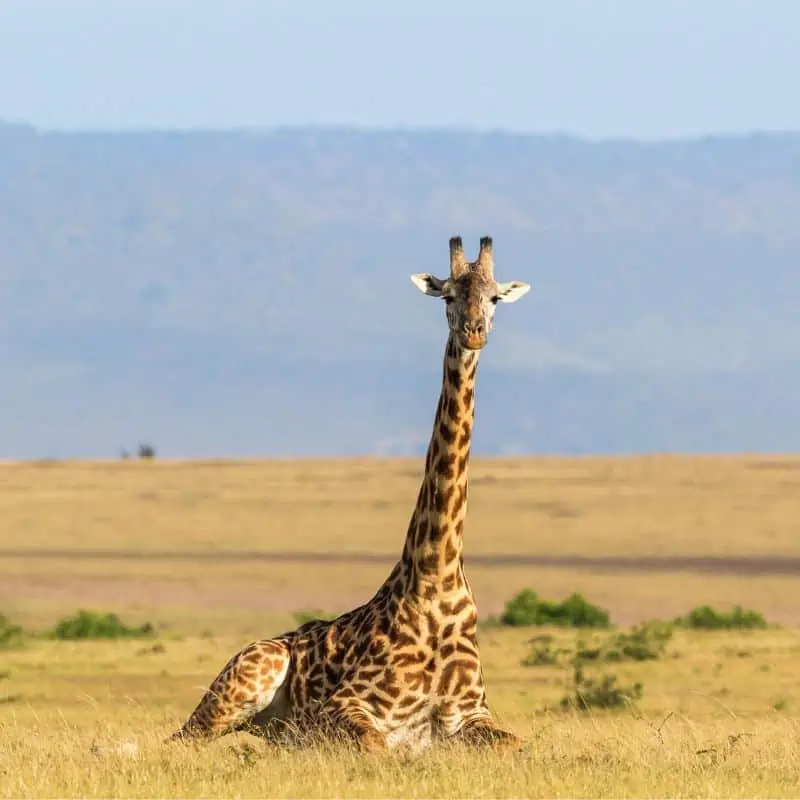Giraffes have a lot of interesting biological adaptations that make them unique in the animal world. It’s quite unlikely that you’ve spotted the rare sight of a giraffe sleeping, but why is that the case? How do giraffes sleep?
In captivity, giraffes sleep about 4 hours each day. They can sleep standing up as well, but when they do, they are still in a half-awake state so that they can detect and escape from predators.
Despite their enormous stature and muscular frame, they are still prey animals, and their sleep habits fall in line with their role in the animal kingdom accordingly. In this article, we’re going to look further into how giraffes sleep and their sleeping habits.

Do giraffes sleep standing up?
Giraffes spend most of their time grazing or moving around, but beneath their relaxed, aloof exterior, they are constantly alert, watching out for predators on the prowl.
As such, their time spent sleeping must be done in a position where they are able to rouse themselves and escape quickly. In the wild, giraffes usually sleep standing up, using a tree to support themselves as they do so.
This kind of position is not particularly comfortable, but giraffes are adapted to survive on less sleep than most other mammals and in less comfortable environments to reduce the risk of being ambushed.
Why do giraffes sleep standing up?
Giraffes are not exactly easy to miss, and their large size makes them a tremendous meal opportunity for predators like lions, hyenas, and leopards, albeit a risky one. A defenseless giraffe on the ground is easy prey for most predators, who can get the job done with a swift bite to the throat.
Giraffes can feed a pride of lions for several days, if not weeks, which makes them a valuable food source. With that being said, giraffes are also fast and can give any would-be predator a hearty kick with their hooves, so there is a degree of risk involved for the predators.
Due to their status as a highly valued target for carnivorous animals though, giraffes have adapted to sleep standing up and spend more of their resting time in a half-awake state like a catnap.
As such, in the wild, deep sleep is fleeting, lasting only a few minutes at a time.
How often do giraffes sleep?
Giraffes sleep less than most other mammals, especially in the wild. Out on the savannah, giraffes are constantly on the move to avoid predation, so their day is broken up into about 8 5-minute sleeps over 24 hours, giving them anywhere from 30-60 minutes of sleep a day.
Newborn calves, of course, will sleep a lot more.
The diet of a giraffe is also instrumental in how and when they sleep.
They are ruminating animals, which means that they must constantly be chewing partially digested food to break it down further. During this time, giraffes may take little catnaps.
How do giraffes sleep in captivity?
One of the most interesting features of giraffes is that their sleep cycle is much different depending on whether they’re in the wild or in captivity.
In the wild, they can get by on just 30 minutes a day and tend to sleep upright to avoid becoming lunch for a hungry predator.
In captivity, however, giraffes have been observed sleeping much more frequently, up to 4 hours a day. Most of this sleep is done at night, and in safer conditions, giraffes tend to exhibit deep sleeping behavior more frequently.
How does a giraffe’s sleep schedule change?
Giraffes are pretty consistent with their sleep schedule, often leaning to take a quick catnap while they ruminate, and the amount of sleep they get stays fairly consistent throughout their lifetime.
Calves, however, do seem to spend more of their time sleeping—up to 6 hours during a 24-hour period.
Just as in humans, stress can adversely affect a giraffe’s sleep schedule. Giraffes in captivity who have lost a mate exhibit symptoms of distress and won’t sleep as much as they normally would.
In a similar vein, giraffes who have been transferred from one zoo to another generally exhibit symptoms of stress and won’t sleep as often.
A change in environment is a new set of unknown variables for the giraffe, which causes it to be more alert and limit sleeping behavior more.
Giraffe Sleeping Positions
Giraffes have different sleeping postures depending on the type of sleep they are getting.
Standing Sleep
First, there is standing sleep, in which you will see a giraffe standing erect and motionless with its head leaning forward, almost like a person nodding off.
This behavior is presumed to be a form of light napping in which the giraffe is still half-alert and aware of its surroundings to some degree.
Recumbent Sleep
Recumbent sleep, the second type of sleeping position, sees the giraffe lying down with folded legs and a leaning neck.

Deep Sleep
Lastly, the third sleeping position is called deep sleep, wherein the giraffe will lie down with folded legs and its neck arched back such that its head can rest on its haunches or the ground nearby.
The second two types of sleeping are extremely risky for a giraffe in the wild. Weighing 2500-4200 pounds, getting back up on their feet to run is no easy task, and even though a giraffe is surprisingly fast, they’re not fast enough that this won’t pose any risk.
As such, recumbent and deep sleep is only really observed when the creature is in captivity. Newborns are more prone to recumbent and deep sleep and can be seen dozing off more frequently.
Final thoughts on how giraffes sleep
Giraffes are prey animals by nature, and their sleep cycle reflects this biological instinct to stay alert for predators.
While they do seem to loosen up a little bit in captivity, the amount of sleep giraffes actually get is astonishing. In the wild, they can manage just 30-60 minutes a day, while in captivity, they average 4 hours a day of shuteye.
If you’ve ever spotted a dozing giraffe, then you’ve seen a rare sight indeed!

